[Previous chapters: 1 to 8 – 1953 – 1985 Roundup, 9 – The Dawn of Eclipse, 10 – Alan Moore at Eclipse, 11 – The Twilight of Eclipse, 12 – All About Angela, 13 – More Angela, More Courtrooms, and Much More Todd]

According to Gaiman, ‘Actually, it looks as if the rights to Marvelman were held by Mick Anglo all that time* – it was always copyrighted to him, not to Len Miller, and Dez admits he had no rights to Marvelman and did nothing to obtain them. Mick Anglo was legally pursuing Eclipse all the years I was writing it, although they never mentioned this to me […] They were working out a deal with him that then died when Eclipse died.’
In 2007, Anglo’s Marvelman/Miracleman rights were sold to Emotiv and Company. As of this writing, there is no resolution. An Emotiv and Company representative simply stated, ‘This is an ongoing situation that will probably still take years to fix.’ Gaiman notes, ‘I know they bought the rights to Marvelman from Mick Anglo for four thousand pounds, and have been working hard to establish his ownership of the property […] I’ve chatted to the guys who bought the Marvelman rights … and wish them well.’
[*Although, in Kimota!, he is quoted as saying, speaking of Dez Skinn publishing Marvelman, ’He had some sort of gentleman’s agreement with Mick, but Mick Anglo didn’t actually own Marvelman.’]
This piece of information about Emotiv seemed to slip under everyone’s radar when the book first came out in 2008, but they became the name on everyone’s lips after a post called Marvelman / Miracleman to the Big Screen? appeared on the ComicMix.com website on the 30th of April 2009 that said,
A highly placed source with one of Hollywood’s leading film production companies has revealed to ComicMix that an agent for a Scottish businessman has been offering around to studios and producers the purported feature film rights to Marvelman, the superhero property whose rights status has been in limbo since publisher Eclipse Comics went into bankruptcy in the middle of Neil Gaiman’s iconic run as its writer more than twenty years ago.
The article later says,
So is this Holy Grail of comics finally about to see the light of day with, at minimum, a major Hollywood film? The answer is that it’s possible, but our investigation casts serious doubts on this latest sales effort.
For one thing, there’s the matter of the original author, Mick Anglo. Still alive by all accounts (though Mick Anglo created the character in the 1950s, putting Mr. Anglo well north of ninety years old), the agent asserts that their rights emanate from Mr. Anglo. Mick Anglo, however, had always had the reputation for maintaining tight control over any derivations from the Marvelman character as Anglo originally conceived it, and our source says that Jon Campbell, the Scottish businessman whom the agent represents, may not have from Anglo a critical waiver of Anglo’s droit morale rights. The phrase refers to the right of a screenwriter and director to take liberties with the story and characters as conceived and depicted in the original source material.
The article itself was a mixed bag, I’m afraid to say, occasionally presenting potential new information, and other times a poorly written and badly researched piece (where did the assertion that ‘Mick Anglo had always had the reputation for maintaining tight control over any derivations from the Marvelman character as Anglo originally conceived it’ come from, for instance, as nothing I’ve ever come across supports it?), leading a lot of people at the time to see it as just another unfounded story about Marvelman, of which there had been plenty, but some people found a link between Emotiv and Company, as mentioned in Prince of Stories, and the name Jon Campbell, as mentioned in the article.
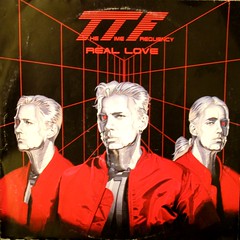
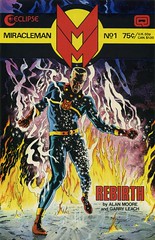
In speaking with Garry Leach recently, co-creator of Miracleman, he tells me there is yet another bizarre twist in the tale. Plans are afoot to completely revamp the character with a new name, a new costume and new artwork but keeping Alan Moore’s words! Garry was not pleased to say the least! That means it is very unlikely that the original Miracleman comics will ever be reprinted as originally intended, everyone please take note of that!
After a potential bidder got in touch with the seller, he said,
All I know is that plans are afoot to revamp Miracleman, they will change the name, the costume etc but still keep Alan Moore’s original dialogue! I have no idea about the other characters but they will probably be revamped too. Garry wouldn’t reveal which company plans to publish this comic but apparently they plan to announce something around the time of this year’s San Diego Comicon so no doubt we will hear something soon!
Obviously enough, the assertions of someone on eBay who is selling the very comics he is talking about can hardly be seen to be entirely unbiased, nor the most reliable of news sources, but it would turn out that at least some of what he said was true.
Before we get to that, though, some further examination of the claim that Emotiv had bought Mick Anglo’s rights to Marvelman is called for. A search through the online files of the UK’s Companies House, the official United Kingdom Registrar of Companies, and the purchase of a few relevant documents from them, reveals a fascinating story.
All along Mick Anglo’s interest in Marvelman seemed to be have been vested in his company, Mick Anglo Limited, as evidenced by his having added a copyright notice in that name to the page from Young Marvelman #38 that he reproduced in Nostalgia: Spotlight on the Fifties in 1977 (as seen in Poisoned Chalice Part 4, back at the beginning of March), as well as other uses of the company name in his work, so it is this company’s history that I have concentrated on.
Mick Anglo Limited was set up on the 21st of August 1954 with a share allocation of 100 £1 shares, with ten of those shares being drawn down and paid for, nine by Mick Anglo, who was the company director, and one by his wife Minnie Anglo, who was the company secretary. A bit over thirty years later, on the 5th of August 1986, the company was sent a letter by the Registrar of Companies telling them that they would be struck off the Register of Companies under Section 652 of the Companies Act 1985, unless reason was given not to. This section allowed the Registrar to strike defunct companies off the Register. Presumably the Anglos raised no objection, and on the 11th of November 1986 Mick Anglo Limited was struck off the Register of Companies and dissolved.
That should have been that for Mick Anglo Limited, but nearly twenty years later, on the 4th of May 2006, the company was restored to the Register after an application to do so by David Livingston of Emotiv on the 31st of March. Jon Campbell was listed as a director of Mick Anglo Limited from the 14th of June 2006, along with Dawn Stevenson, who is currently the company secretary, a position she also holds at two different Emotiv companies. Soon afterwards, on the 25th of June 2006, both Mick Anglo and his wife Minnie resigned as officers of Mick Anglo Limited, only a few days after Mick Anglo’s ninetieth birthday. On the 24th of August 2006 the remaining 90 of the 100 £1 shares in the company were allotted to Jon Campbell. Immediately after that, all the outstanding accounts and returns for the company for the previous twenty years were brought up to date.
At the moment there are only two officers listed for the company, Jon Campbell and Dawn Stevenson, and the most recent statement of capital I have looked at, on the 21st of December 2010, shows that, of the 100 £1 shares that the company was originally set up with, all of them are currently owned by Jon Campbell, in his own name,. The ten shares that Mick Anglo and his wife had owned were no longer theirs, so I can only surmise that they were sold to Jon Campbell, and presume this was what Neil Gaiman was referring to when he is quoted in Prince of Stories as saying,
I know they bought the rights to Marvelman from Mick Anglo for four thousand pounds.
[All of the relevant documents relating to Mick Anglo Limited can be found in this folder on my own Flickr account, for those of you who are interested. There’s too many of them to publish here, and they’re not the most visually stimulating, but if you’re interested, go copy them, in case anything happens to them!]
After they had bought out Mick Anglo and his wife for £4,000, the next thing that Emotiv did was to contact some of the individuals who had become involved with the Marvelman property after its L Miller and Son incarnation. This seems to be backed up by that article on the ComicMix.com website in April 2009, which said,
According to our source in Hollywood, the information from the agent showing the rights around reflects that there has been a lot of ownership movement between Mr. Anglo, Mr. Campbell, and various business entities, necessitating, one presumes, a lengthy stack of warranties and indemnities from Anglo, Campbell and the several businesses that purportedly held title at various times.
This meant talking to the people who had produced the 1982 version of Marvelman in Warrior, to tell them that they had actually been using a character that was now apparently owned by Jon Campbell, which he felt they hadn’t had the right to use, despite the fact that Mick Anglo not only hadn’t objected at the time, but had apparently given it his whole-hearted support. Dez Skinn, for instance, was approached, and eventually signed a waiver of any rights his company, Quality Communications, may have had in publishing the character.
Dez Skinn was not the only one contacted, either. Alan Moore told me,
Somebody from Emotiv called me up and explained that they had been working with a son of Mick Anglo’s who was a musician, that this son had told them something of the Marvelman story, that they had decided to get involved, because it sounded to them as if Mick Anglo was being cheated, so they told me a few things – such as the fact that L Miller hadn’t gone bankrupt. […] As soon as I knew that the rights to Marvelman had never been with the Official Receiver, I said, ‘well, if I’d known that, I would have never taken the job, and, yes, if I can help, I do feel bad that I must have been instrumental in taking these rights from their rightful owner, whoever that might be.’
I felt that OK, yes, I know that it’s because I wrote Marvelman the way that I did that it became the work that it’s become, but the fact remains that I had taken somebody else’s property without knowing that that was what I was doing, because I was being assured that this wasn’t what I was doing […] and I just thought anything that could actually get Mick Anglo some money at this point in his life, when it sounds like he could use it – if there was anything I could help towards that, then I was prepared to do it. So someone came down to Northampton, eventually, and filmed an interview with me where I just answered all the questions that they asked me as honestly as I could, and there may have been some other back and forth. I haven’t spoken to any of the people from Emotiv for a couple of years now. I mean, once I’d signed all the – done the interviews and done everything else, that seemed to be sufficient for them to progress.
One thing that I said at that time was that I was prepared to – if they brought out a collection, if somebody brought out a collection of Marvelman, then I would want all of the money from the first edition to go to Mick Anglo. This was at a time when I though, yes, I did do a lot of the work on it and it would be nice if, I don’t know, Leah and Amber, or Mel, were to profit from it in the future, but by the time that Marvel Comics were involved I just though, no, let it go, give all the money to Mick Anglo, which is more tricky than it – it looked like it was going to be quite easy to do, but then I kept getting all these contracts that didn’t want me to – didn’t seem to want me to give the money to Mick Anglo, or to take my name off of it. Eventually I signed one that did state just that.
One thing that was becoming clear was that the news story on ComicMix at the end of April 2009 contained at least some amount of truth after all. There was a Scottish businessman called Jon Campbell who claimed to have some or all of the rights to Marvelman, and who was attempting to find an interested party in America to deal with. As well as that, there was that seller on eBay in May 2009 who had said, amongst other things,
Garry [Leach] wouldn’t reveal which company plans to publish this comic but apparently they plan to announce something around the time of this year’s San Diego comicon so no doubt we will hear something soon!
This would turn out to be true, as well.
But, before we get to that, there was another bidder who was trying to secure the rights to Marvelman from Jon Campbell and Emotiv. Let me return to that seller on eBay, who had quoted Garry Leach as telling him,
Plans are afoot to completely revamp the character with a new name, a new costume and new artwork but keeping Alan Moore’s words.
Was there any truth in this? Surely there couldn’t be a plan to replace, for instance, Garry Leach’s or Alan Davis’s beautiful artwork, could there? Perhaps there could. I mentioned this story to one of the artists who had worked on the series, who told me,
I was contacted some years ago by a lawyer representing one of the new Marvelman ‘owners’. I was told they wanted to reprint my work in a new collection. I said I would be prepared to allow that IF I was paid enough. The lawyer said I would get the same flat-reprint rate as all other artists and if I withheld my pages in an attempt to increase my reprint rate they could easily be redrawn. So I told him to have the pages redrawn. I mention this incident only because it may be linked to the rumour you heard.
It’s worth pointing out here that there were several other parties who might have been meant by ‘one of the new Marvelman ‘owners’,’ besides Marvel Comics, and that the incident referred to seems to predate Marvel’s involvement with Marvelman, in any case.

In a podcast interview conducted by Orbital Comics of London in March 2011, Elliott revealed that he had been one of the people involved in a bid to licence the rights to Marvelman from Emotiv, before they sold the rights to Marvel Comics. He said,
There was a project we were so close to doing a couple of years ago. We were the other party after Marvelman – we’d even been exchanging contracts, closing on it. Our approach was – we weren’t buying Marvelman. We were going to republish Alan’s material, and do a film.
We weren’t directly dealing with Alan, but, when we first started, and we were going out to shop the film, I wouldn’t do it without something in writing from Alan saying that he knew we were doing it, because the last thing we wanted, was it to get out in the trades, you know, some gossip like, ‘Oh! Apparently Marvelman is being shopped in Hollywood!’ I wanted something in writing, so Alan said, ‘Yup, you’ve got my blessing. Off you go, as long as my name’s not on it’ – which is the standard thing for Alan recently.
So that was great, you know. I wanted Alan to be comfortable, because I know for all the creators involved in Marvelman it’s been a very bumpy ride over the last twenty-odd years.
The bid had previously been referred to in a story by Rich Johnston on the Bleeding Cool website on the 10th of August, 2009, although at the time it was only referred to as ‘The other bid,’ without any names being attached to it, the bidding party simply being referred to as The Anons. Johnston said,
The negotiations took over two years, and contracts between the Anons and Emotiv were drawn up three weeks before the Marvel announcement, when suddenly Emotiv stopped returning calls and e-mails to the Anons. This was after they asked about a contract clause – in that they would have had to sign a statement that Emotiv were not responsible for the legal rights that the buyer would or would not buy. So if there was a subsequent challenge to them, the buyer not the seller would be responsible for all legal fees to fight it.
Briefly, what the Elliott group intended to do was to licence Marvelman from Emotiv – rather than buy the character from them outright – and with the consent of all the other copyright holders – Moore, Leach, and so on – to produce three films based on the three books of Moore’s run on the character; to publish the three volumes of Moore’s run with new artwork, all done by a single artistic team, possibly with Garry Leach involved; to also republish the books in Moore’s run as they had originally appeared, with the original artwork; and to then go ahead and produce two new mini-series, both set in the time before Moore’s story started.
Dave Elliott explained to me what these would have been:
One was the origins of the [Zarathustra] project, including a second scientist working with Gargunza who was actually the one responsible for starting it. As Gargunza used himself in the stories as the villain, this scientist was the Astrophysicist. The other series would be Johnny Bates’s story, from the bomb going off in 1963 to Marvelman coming back in 1982. I’d actually reached out to Grant Morrison to see if I could use the material in his story that was never published.
Of course, despite Marvel having lifting their objections to anyone else using the name Marvelman when Neil Gaiman set up Marvels and Miracles, it was possible that they might reverse that decision, so a new name was devised: Marvelman would no longer be Miracleman, he would be Masterman. Emotiv had even gone to the trouble of having a logo made up, just in case they needed it.
It could be said that this bid, with a group of people including Dave Elliott and presumably Garry Leach also, would have been in a position to make contact and deal properly with the various people involved, and in a reasonably short amount of time. However, their bid was ignored, right at the eleventh hour, and this is what happened instead…
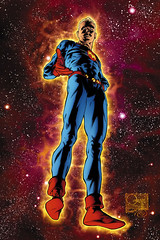
The biggest news of Comic Con International in San Diego was revealed moments ago and jaws are still on the floor – the world-renowned superhero Marvelman is now part of the Marvel Comics family! Marvel Comics has purchased the rights to Marvelman from creator Mick Anglo and his representatives, finding a home for one of the most sought after heroes in graphic fiction!
‘It is an honor to work with Mick Anglo to bring his creation to a larger audience than ever before,’ said Dan Buckley, CEO & Publisher, Print, Animation & Digital Media, Marvel Entertainment Inc. ‘Fans are in for something special as they discover just what makes Marvelman such an important character in comic book history.’
Originally created in 1954 by Mick Anglo and appearing in some of the most celebrated comic stories of all time, Marvelman is Micky Moran, a young reporter gifted with the power to save the world by simply uttering the word ‘Kimota!’
‘I did not think it would ever happen,’ said Mick Anglo. ‘It’s a wonderful thing to see my creation finally back.’
Marvelman is back and he’s found a new home at Marvel Comics! What’s next for Mick Anglo’s legendary creation? Stay tuned to Marvel.com for all the news on Marvelman and this exciting new addition to the Marvel family!
In the following few months, there was furious speculation on the Internet and in the comics media as to what was to happen. One thing that stood out for me was that, in all the statements and interviews that Marvel gave at the time, the name Miracleman was never once mentioned. Neither, for that matter, was the name of Alan Moore. And, once again, as with Todd McFarlane’s supposed purchase of the rights to Miracleman, the question that everyone really wanted to know the answer to was, what exactly had Marvel bought? It was a good question in July 2009, and it’s still a good question now. Another good question was, and is, what were they intending to do with it now that they’d got it?

However, and despite their saying they would have news about it ‘soon,’ anyone who was waiting for an announcement from Marvel about their plans to reprint Alan Moore and Neil Gaiman’s work on the title is still waiting (there’s an incomplete collection of those ‘coming soon’ announcements here, which I really need to update). The listing for the Marvelman Classic Primer on Marvel’s website said,
Who is the mysterious Marvelman? The answer to that question is one of the most mysterious in comics lore. Created in 1954 by writer/artist Mick Anglo, the character enjoyed a long run in the British comics market as one of its most powerful heroes. A few decades later, the character was revived with a dark, moody, deconstructionist bent, and produced one of the most important works of comic art in the medium’s history.
But now, miracle of miracles, Marvel has stepped up to the plate to deliver on the promise of Anglo’s incredible characters. The Marvelman Primer will help readers unfamiliar with that character get up to speed on the past, present and future of Marvelman stories. We’ll check in with Mick Anglo, Neil Gaiman and others who contributed to this character’s history over the years. It was the news that swept the 2009 San Diego Comic-Con and the Marvelman Primer explains why.
Leaving aside the obvious hyperbole – ‘The answer to that question is one of the most mysterious in comics lore’ – and the somewhat ominous foreshadowing of what their plans for the character might have been – ‘Marvel has stepped up to the plate to deliver on the promise of Anglo’s incredible characters’ – it did look as though Marvel really were going to explain what their plans for the character were, and the fact that Neil Gaiman was to be in it would seem to suggest they were going to talk about the later incarnation of the character, and not just the Miller-era stuff. However, this never came to pass. The Primer was published, but there was no interview with Neil Gaiman in it.
There was the promised interview with Mick Anglo, however, talking to Joe Quesada, who travelled to England to meet him, but Anglo really had nothing to say about Marvelman, with most of the interview being about his days in the Second World War. He actually only referred to Marvelman three times, saying, firstly,
My brother called me Gargunza. He said I was an ugly-looking fellow. That was my brother!
Marvelman is one word: I’ve seen it on milk powder, on special products for babies. Marvel was a good name. It was unique, simple, and it means a lot. I liked drinking Marvelmilk! I’ve got a Marvelman T-shirt. I don’t know who gave it to me. The silly thing comes down to my ankles.
Finally, apparently in answer to a question about the possibility of the success of a Marvelman revival, he said,
I don’t like taking anything for nothing unless it’s in big quantities.
And those three statements are the sum total of what Mick Anglo said to Joe Quesada about Marvelman, at least according to what is printed in the interview in Marvelman Classic Primer. It’s worth bearing in mind that, at the time of the interview, Mick Anglo was 94 years old and, sadly, there’s a very real possibility that he didn’t fully understand what was going on, or what he was being asked about.
The rest of the Marvelman Classic Primer consisted of a very brief and incomplete history of Marvelman, more or less beginning in 1953 and ending in 1954; an article about Marvel UK; any amount of Marvelman artwork by recent Marvel ‘superstar’ artists, but virtually none by any of the original 1950s artists, with what there was by them usually being unattributed, unless it was attributed to Mick Anglo; and a history of British comics, which included this paragraph:
In 1982, Dez Skinn – who, during his reign as Marvel UK Editor in Chief, had successfully resurrected the idea of UK-originated material with Hulk Comic and Doctor Who Weekly – launched Warrior, a groundbreaking anthology. A launch pad for the careers of John Bolton, Alan Davis and others who had also contributed to Skinn’s 1976 title House of Hammer, it led the way when it came to offering the more mature British reader an alternative to traditional comics fare.
For whatever reason, Marvel seemed to be going out of their way to avoid any mention of Marvelman past the Miller-era run, even mentioning Warrior, the very magazine it was resurrected in, without mentioning the strip itself, or Alan Moore, its famous writer, without whom nobody would actually be interested in the very character they were touting. It was becoming obvious that something odd was going on at Marvel, and that things might not be as straightforward as they had originally appeared to be.
And it was becoming apparent that nobody really cared about the reprints of those old 1950s Marvelman comics. The sales figures for both the hardback books and the comics reprinting the 1950 Marvelman stories were very poor, and Marvel abandoned Marvelman Classic after volume 3, which had sales below 300, and Young Marvelman Classic after volume 2, which had sales below that again. The reprint project has been in abeyance since January 2012, and it’s unlikely ever to resume.
However, it was obvious to anyone with eyes to see that these weren’t Marvel’s primary target in buying the rights to Marvelman. After all, Marvel Comics are not in the business of buying up the rights to what are really pretty bad old British comic stories that haven’t stood the test of time too well, just to reprint them in expensive hardback books that have a very limited market, particularly if one rumour, which holds that Marvel paid Jon Campbell $1,000,000 for the rights he held, is to be believed. Their primary reason for buying the property can only have been to reprint the Moore and Gaiman stories, the very things they avoiding even mentioning. I’d like to think that they have some sort of a plan, but at the moment it seems as if nobody actually knows what it is, perhaps not even themselves.
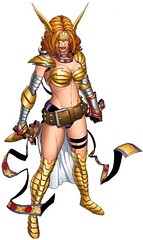
UGO: Has the Miracleman film gone back to Neil Gaiman or wherever it is supposed to go?
TMcF: With the lawsuit, Gaiman walked away from Miracleman. I have the trademark for Miracleman. No one wants to say it out loud, but that’s what happened with the lawsuit. Everyone was like ‘Hah hah, he killed Todd,’ but unfortunately – or fortunately, depending on where you are standing – he had to pick some copyrights to some Spawn characters or pick Miracleman. He didn’t pick Miracleman.
UGO: Did he take Angela?
TMcF: Yeah, he took some of the Spawn stuff. For whatever reason he walked away from Miracleman, so now Miracleman will be in the Image 10th Anniversary Book.
When the interviewer said ‘Did he take Angela?’, was this actually an indication that Neil Gaiman was after full ownership of the Angela character all along, and had actually secured it fully eight years and more back? Certainly the whole thing, where Marvel were suddenly talking about publishing Angela, as if it was part of the plan all along, is pretty peculiar – as is McFarlane’s comments on the whole situation, where he said,
“Neil Gaiman and I had a resolution in our legal dispute, and as part of that he ended up with the rights of Angela. Whatever Neil chooses to do with something that he owns is at his complete and utter discretion.
The health of the industry is based upon having good stories and good characters, and a wide customer base. If bringing some of these characters back to the fold in a meaningful way adds to that, then it just strengthens our industry.
Good stories that entertain are something that we all should applaud on any level. Whether we’re doing it directly at Image Comics, or at our competition, it helps keep our industry that we love alive. I will sit back and be as interested as anyone else.”
Who was this man, and what had he done with the Todd McFarlane we knew and loved?
And, somewhere along the line, McFarlane’s last attempt to claim a trademark on Miracleman was abandoned, and this was quickly followed up by Marvel Comics claiming the trademark on the name instead. What did this mean? Much like everything else, I don’t really know, and they’re not telling me, but I may speculate on it later on.
I did do some actual speculation about whether or not Marvel had succeeded in buying Garry Leach‘s share of the rights to various things, particularly including his half-share of Warpsmiths, which would include the crucial rights to the Qys technology, the backbone on which Alan Moore’s version of Marvelman is build, here, but as it is simply that, speculation, I don’t know if it even belongs here. None the less, it is not without interest, I hope, and I’ll also be referring back to that later on.
And, really, that’s it. That’s the Marvelman story pretty much right up to date. Over the next few weeks I’m going to be going back over it all again, first to try to condense it all into some sort of comprehensible whole, and then to try to finally answer the question that started me off on this quest, maybe ten years ago now: Who Owns Marvelman?
Thanks to everyone who has hung on this long, and who have given me such valuable feedback. Courage, mes braves, the end is in sight! To you all I address the question, before I start to wrap it all up, is there anything I’ve forgotten? Anything I haven’t made clear? One of the guiding principles for this, from the beginning, was to cast light into corners, but to do so using verifiable sources, by telling the story out of the mouths of those involved, and I hope this is what I’m achieved. But now’s everyone’s chance to ask me about everything, before I’m finally done with this, and I shall do my best to answer as plainly and honestly as I can.
Oh, yes, there’s one other thing: I’ve one more witness to bring forward, a man I’ve been keeping behind the curtain for a very long time now, who casts a very interesting light on, well, pretty much everything. See you all back here next week!
To be wrapped up, and concluded, very very soon now…
[The Marvel Milk photograph is copyright to Edward Coughlan, and is used without permission, but in good faith!]


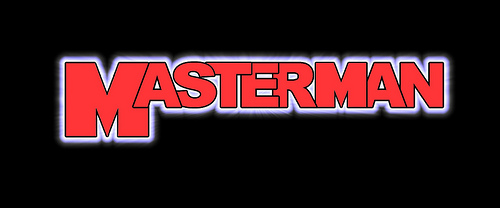
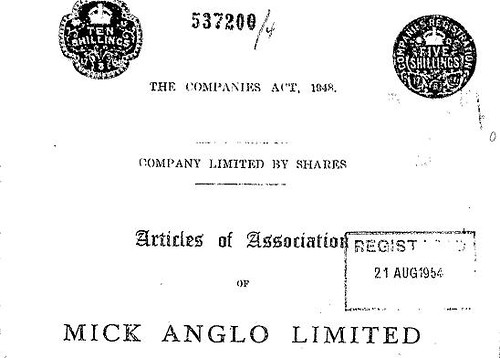
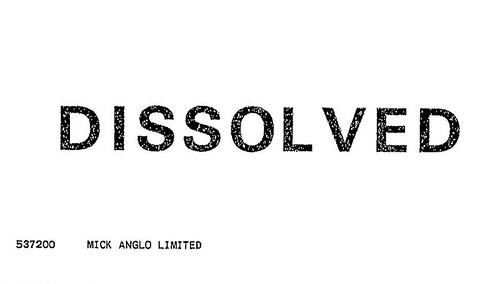
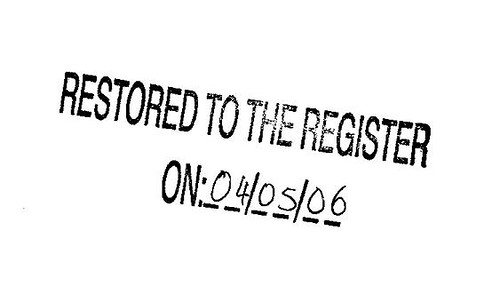
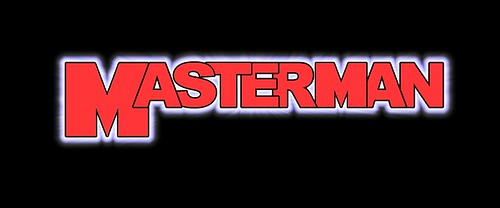






“Masterman” sounds ominously Nazi to me, but perhaps that’s because I’m thinking of Grant Morrison’s first ‘Zenith’ arc (itself an acknowledged knock-off of MM – among other things).
At the very start of this chapter: I’m not sure that there’s a huge discrepancy between what Gaiman says about Skinn and Anglo in Kimota! and what he says in Prince of Stories, given that they were published 7 years apart and things had got even more convoluted in the interim.
I think what’s interesting is that he changed his mind. What caused that to happen? That’s one of the things that I’ve been trying to unravel for quite a while now.
Yes, Masterman has a distinctly ominous sound to it, especially when applied to a blonde-haired, blue-eyed superhero. They might as well have just called him Captain Aryan, and been done with it.
Master man was a Nazi Superman that appeared in Marvel Comics over the years.
http://en.wikipedia.org/wiki/Master_Man_%28Marvel_Comics%29
There was a Fawcett Comics character also named Master Man, who had Superman-ish powers. DC is said to have threatened to sue Fawcett over the character (like they did Fox for Wonder Man) and the character was stopped.
The only bit of information that would be nice to know is a summary of who owns what of the 80s material.
Alan Moore gave his rights to Mick Angelo, who sold it to Marvel.
Neil Gaiman and I believe Mark Buckingham transferred their rights to Marvel and Miracles.
But Gary Leech? Alan Davis? Chuck Austen? Rick Veitch? John Totleben?
Also a section for people who own characters that are in the story and would require permission to reprint. Even if some of them are unknown that would be nice (maybe some of them would chime in).
If only to see what the “score card” is of who is left to get agreements with to get the series back in print.
This is the most interesting chapter to me — I didn’t know most of this.
This para:
“The sales figures for both the hardback books and the comics reprinting the 1950 Marvelman stories were very poor, and Marvel abandoned Marvelman Classic after volume 3, which had sales below 300, and Young Marvelman Classic after volume 2, which had sales below that again.”
I would change “sales” to “orders” in all instances, and would further add “…after volume 3, which had initial orders below….” or possibly “initial orders from comic book stores”.
But that’s nitpicking, probably.
-B
Jamie: The Fawcett Master Man gets a walk-on part in Poisoned Chalice Part 1, about a half a dozen paragraphs down.
Alan Moore gave his rights to Mick Angelo… Nope! I’ll straighten that out in the next week or two, but that’s a common misconception, which is a few different things conflated together, and misunderstood. The rest of the things you mention are forthcoming.
Brian: Yes, very good point, of course, which is definitely worth clarifing. Orders are not necessarily sales. The same thing applies to ‘sales’ of those appalling Before Watchmen comics, of course.
At this point I´m tempted to selfpublish a comic about a character called “MisterMan” who coincidentally looks a lot like MarvelMan just to see what happens…
My two cents: in spite of trademarks and legal crap it´s kind of ridiculous to think that it´s the trademark the thing that makes MM MM a “hot” propierty: it´s the talent of Moore/Gaiman/Leach/Davis that makes it a unique opus and everybody seems maniacally invested in bullying them instead of getting them on their side so to at least we could get a decent TP published. With the McFarlane sculpture we have a pretty good and solid idea what MM would turn up to be; thanks, but no thanks.
C’est la vie, I guess.
Great and compelling work, Padraig!
I still love you though – w4m (Out here)
You opened it. Good luck. Tonight at midnight your true love will realize they miss you. Something good will happen to you between 1:00 pm and 4:40 pm tomorrow, it could be anywhere.Tonight at midnight they will remember how much they loved you. You will get a shock of a lifetime tomorrow, a good one. If you break the chain you will be cursed with relationship problems for the next 2 years. Karma. If there is someone you loved,or still do, and can’t get them out of your mind, re-post this in another city within the next 5 minutes. Its amazing how it works.If you truly miss someone, a past love,and can’t seem to get them off your mind….then re-post this titled as ” I Still Love You” Whoever you are missing will surprise you. Don’t break this, for tonight at midnight, your true love will realize they love you and something great will happen to you tomorrow. Karma.You will get the shock of your life.
Wow, it’s nice to see some actual evidence of the Atomeka plans. A few years ago I was talking to someone who knows, or claims to know, Gary Leach and he was telling me Leach was going to redraw the entire Moore run just so it could be published again. I never heard anything further about that until now and I thought it was just idle chatter.
I think this whole story is fascinating. You answered the biggest question I had with the Atomeka section. Also, that section on what Moore signed is pretty fascinating, too. I was a bit confused about that before.
If you do go to publish this, I have a small request…transcripts of interviews with Gary Leach and Dez Skinn would be appreciated! I mean, if everyone isn’t comfortable with it, I understand, but those are two guys who don’t do a lot of interviews and I would love to read them.
Maybe I’m naive but I never understood McFarlene or Marvel or any company with an established universe wanting Marvelman. His status as a god in the story we want to see the end of is enough to make sure he’s not going to pop up alongside Captain America, Sentry showed us all how that would go.
Marvelman is unique in that it isn’t him that anyone wants, it’s the story. Sure Gaiman’s run began with Marvelman as more of a presence rather than a character. It’s Marvelman’s world that will be useful for the longterm, the character could be just as effective hiding in the shadows of Olympus.
Thanks once again Padraig for all your research into the legal rights of Marvelman. It’s been quite the ride and quite the interesting read and I look forward to what you have left next week.
I’m confused about Anglo’s interest in any of this after selling all his rights to Jon Campbell in 2006-2010. When allegedly “Alan Moore gave his rights to Mick Anglo”, had Anglo already sold all his rights to Campbell and/or his Emotiv company? In which case, had Moore been manipulated into handing over rights to Campbell under the false pretenses that he was thereby helping Campbell? Or was he giving Anglo a bundle of rights separate from what Campbell held? If Anglo no longer held any shares in Mick Anglo Limited or perforce Emotiv, why would Anglo have received any part of Marvel’s million-dollar payout to Campbell? Likewise why would Marvel’s press release say: “Marvel Comics has purchased the rights to Marvelman from creator Mick Anglo and his representatives” if Anglo no owned these rights? Padraig, can you clarify any of these points, which I found murky in your otherwise excellent article.
BTW, it’s strange seeing Anglo described as “creator” of Marvelman & Young Marvelman given that his version was a transparent ripoff of Captain Marvel & Captain Marvel Junior, so I’m surprised DC/Time Warner never got involved in the legal free-for-all.
Typo correction: “In which case, had Moore been manipulated into handing over rights to Campbell under the false pretenses that he was thereby helping Anglo? Or was Moore giving Anglo a bundle of rights separate from what Campbell held?”
Padraig,
Thanks for an interesting collection of updates. Somewhere in my chattels are some of those first few issues of Warrior in all their B & W glory which somehow managed to make it to South Africa.
I would like to echo Stephen’s query concerning DC, you started out this series with a review of how vigorously DC defends it’s Superman property, and MM is essentially a Captain Marvel clone (now owned by DC) and CM is legally deemed to be a Superman clone. I can see how Warrior and subsequently Eclipse may have escaped DC’s notice, but Marvel?
Sir,
One thing that I have always wondered for as long as there has been Mircaleman comics and bottles of diet Coke with lime in it, is if Marvelman was basically Captain Marvel transformed into a British super hero, wouldn’t DC Comics step in and say, “Ummm. No.”
Your article are most excellent and I look forward to them and at times have helped me divert my mind when my girlfriend was very, very sick. Thank you.
Thanks very much of putting all this together for us! Your research is very much appreciated!
If Marvel ever does do something with Miracleman / Marvelman, I would find it interesting to see if people would react in the same way that they reacted to the Before Watchmen comics.
As someone who was opposed to Before Watchmen, the continuation of Marvelman doesn’t strike me the same way. The big reason would be that the precedent has already been set for passing the torch for the character with the switch from Moore to Gaiman.
As long as Gaiman is cool with someone else taking the reigns, why would fans object?
Having said that, I have no interest in Marvelman joining the Avengers or interacting with the general Marvel universe.
Superb articles, thanks for being the guy who goes out there and does the research. Probably safe to say you know more about the ownership of the character and the material than anyone who’s claimed to own it over the years…
“If Marvel ever does do something with Miracleman / Marvelman, I would find it interesting to see if people would react in the same way that they reacted to the Before Watchmen comics.”
They won’t. Totally different scenario.
“to publish the three volumes of Moore’s run with new artwork, all done by a single artistic team, possibly with Garry Leach involved”
Not quite, it was to have a different penciller for each book but for Garry Leach to ink them all.
“As someone who was opposed to Before Watchmen, the continuation of Marvelman doesn’t strike me the same way. The big reason would be that the precedent has already been set for passing the torch for the character with the switch from Moore to Gaiman.”
I’d also suggest that since MM wasn’t Moore’s creation then it would be no more controversial than, say, other writers handling Swamp Thing.
Having said that, I do want to see The Silver Age/The Dark Age storylines published and would be quite annoyed if that didn’t happen.
The fact that Marvel haven’t done anything different with the Anglo character (which they would seem to be well within their rights to do and would also sidestep any of the other complicating baggage that’s arisen over the years) suggests to me that they want to keep fidelity with the Moore/Gaiman version. But my instincts could be entirely wrong here.
“They won’t. Totally different scenario.”
You’re right. In the case of Before Watchmen, DC had every legal right to publish those comics.
As we can see from these articles, even if Marvel thinks they have the right to do so, they may not.
But hey, I’m sure people will rationalize it in whichever way they want.
So your question was asked with an agenda? Gotcha, ignored.
Hate to ask this, but here goes…
Everyone wants a scorecard about who in the Miracleman run has given a blessing to reprint their work.
So let me open a can of worms…
What about “Miracleman Apocrypha”?
http://www.comics.org/series/4262/
My hardcover copy (neener neener) is buried deep in my storage locker, so I can’t access the indicia. Was it work-for-hire?
Matt Wagner, James Robinson, Kurt Busiek, Alex Ross (before Marvels!), just to name a few…
@majorjoe…
No agenda. I just find myself amused by moral ambiguities and how different people respond to them. I especially find it amusing when people take a very adamant stance on one side, and then quickly change that stance when a different scenario (esp. something personal) comes into play.
@Torsten
I find that to be a very interesting question. Are the Poisoned Chalice articles about who owns Marvelman, or are they about who owns reprint rights? Are they one in the same, or are they separate items?
Jonboy, can you explain why you see BW and MM to be analogous? I don’t see many of the same issues involved. MM has been held up by legal ambiguities, to be sure, but how is that like BW? I want to understand what you mean.
Hi Padraig. Just wanted to join in the chorus of ‘Thanks’ for all the work (and the cash you’ve probably shelled out for the Companies House documents!)
Fascinating stuff. It seems everyone is now in agreement that Dez Skinn never owned any rights to Marvelman, which seems unusual given the time and money Neil Gaiman has poured over the years into protecting something he now concedes he doesn’t own. Each step along the path toward resolving this only seems to complicate things even more.
Would I be right in thinking that the legal position on Moore/Gaiman et al’s work now would likely be that it’s an unlicenced derivative work? Effectively a bootleg produced without any approval from the rights holder (Anglo)? That would seem to strengthen the case for Marvel reprinting the work (and presumably paying nothing to anyone, as they do with a large portion of their collections anyway). I wonder what the hold up is? Wanting to keep Gaiman on-side? That sounds to me like a Levitz/Watchmen style disaster just waiting to happen once Quesada moves on…
Just to throw another iron in the fire, what if Mick Anglo was wrong and L. Miller & Son owned the copyright? They seem to have gone into voluntary liquidation in the 1990’s and, if the Marvelman rights weren’t dealt with then (as presumably everyone at Miller’s either didn’t know or didn’t care about it) the rights would have transferred to one or more of the directors post-insolvency. I’m sure Marvel’s lawyers have already answered this to their own satisfaction but what if there’s another previously uninvolved party out there with a claim? Food for thought.
Did Mick Anglo really only get £4,000 total for his Marvelman rights or am I reading that wrong? Seems like a huge Siegel/Shuster style bargain for Marvel/blow to creator’s rights if so…
A further thought – if Marvel do acknowledge that Gaiman et al have rights to the Eclipse work, that would most likely once again bring McFarlane out of the woodwork.
I know you’ve cited a clause in the Eclipse contract in the past which seems to invalidate McFarlane’s claim (that the rights would revert if Mullaney disposed of them) but bankruptcy has a nasty habit of invalidating exactly that sort of clause (look up ‘ipso facto clause’ for more info).
And of course there are McFarlane’s comments about Gaiman trading off Angela for Marvelman. Speculation of course, but were Marvel to acknowledge the ‘rights’ of any of the Warrior/Eclipse creators they could well be opening the door to McFarlane taking a controlling stake in the material that, let’s face it, was the reason they shelled out so much dough in the first place…
I’m not sure the term “creator’s rights” is applicable to Anglo, given that his Marvelman was arguably “an unlicenced derivative work” or “bootleg” of Fawcett/DC’s Captain Marvel. But that’s what’s so ironic about the whole MM imbroglio being an internecine inbred mutual legal brawl among ripoff artists big & small.
Padraig, again I hope you clarify in your final (?) installment whether Anglo had already sold all his “rights” to MM away by 2010, and if so why would he have benefited when Moore “signed one [contract] to give the money to Mick Anglo” and again when Campbell got paid off by Marvel.
Thanks for all the questions and comments, all of which I’ll get to. I’ve actually ended up writing an addendum to this piece, because a couple of people pointed me at a couple of things, which, after some furious Googling, and putting some connections together, I’ve decided to write up before next Sunday’s piece, which will probably only be the first of several posts to wrap all this up. And there were a few other things I wanted to clarify, while I was at it. Tomorrow at noon-ish, hopefully. Then I’ll come back and answer anything here I haven’t addressed in that.
Thanks for all your fascinating research, Padraig… I very much look forward to your follow-up posts!
Sorry – didn’t have the piece finished on time. Almost definitely on Wednesday at noon, though! As my old mate Alan says, nobody in the future is going to say ‘yes, but it’s marred by the fact that it was three weeks late’…
Oh No! Not yet another afterthought on Miraleman?
a) why does Philip Wylies Gladiator get lft out of the Marvelman / Miracleman history? (the origin of the Americn superstrong hero)
b) why does the American fairground stongman ge left out ? (the origin of the costumed hero)
Graham
Comments are closed.